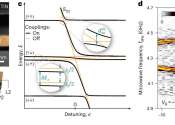Devastating plant virus is revealed in atomic detail
The complex 3-D structure of one of the world's most lethal families of plant viruses has been revealed in unprecedented detail by scientists at the UK's University of Leeds.

The complex 3-D structure of one of the world's most lethal families of plant viruses has been revealed in unprecedented detail by scientists at the UK's University of Leeds.
Biochemistry
Jun 18, 2018
0
122

We can't cram any more processing power into silicon-based computer chips. But a paper published in Nature overnight reveals how we can make electronic devices 10 times smaller, and use molecules to build electronic circuits ...
Nanophysics
Jul 12, 2018
0
20

Researchers at the Energy Department's National Renewable Energy Laboratory (NREL) discovered single-walled carbon nanotube semiconductors could be favorable for photovoltaic systems because they can potentially convert sunlight ...
Nanomaterials
Apr 26, 2016
0
415

Researchers from the University of Basel and the NCCR SPIN have achieved the first controllable interaction between two hole spin qubits in a conventional silicon transistor. The breakthrough opens up the possibility of integrating ...
Quantum Physics
May 6, 2024
0
61

Utah State University biochemists Thomson Hallmark and Ryan Jackson, along with collaborators, published two seminal papers this week. Their findings describe the structure and function of a newly discovered CRISPR immune ...
Biochemistry
Jan 4, 2023
0
186

Cilia, or flagella—whiplike appendages on cells—perform diverse tasks required to keep the body healthy. When cilia malfunction, the consequences can be devastating, causing a range of problems, from blindness, to lung ...
Cell & Microbiology
Nov 22, 2019
1
166

In molecular electronics, single molecules are stretched between two electrodes to form an electrically conducting element in which molecular conductivity is then measured. Although the underlying method for this phenomenon, ...
Analytical Chemistry
May 19, 2022
0
62

Amazon called on writers and publishers on Tuesday to submit short works to a new section of the US online retail giant's electronic bookstore called "Kindle Singles."
Other
Oct 12, 2010
1
0

Scaling down information devices to the atomic scale has brought the interest of using individual spins as a basic unit for data storage. This requires precise detection and control of spin states and a better understanding ...
Materials Science
Nov 11, 2021
0
44

An international team of researchers led by the National Physical Laboratory (NPL) and the University of Bern has revealed a new way to tune the functionality of next-generation molecular electronic devices using graphene. ...
Nanomaterials
Jun 12, 2017
0
21